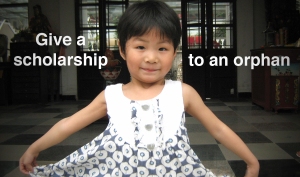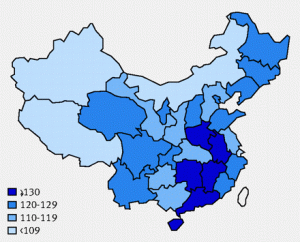Esta é a realidade do controle populacional na China. milhões de bebés mortos por ano, crianças meninas são abandonadas, mulheres grávidas são levadas ‘a força pela policia de aborto coercitivo, morrem as mães por falta de atendimento ‘a saúde inclusive após o aborto provocado pela policia. Hoje a população da China tem – 27 milhoes de homens a mais do que mulheres por causa do generocidio; – abandono; – suicidio; – trafico de crianças, pois meninas são mortas; – meninas, vitimas do programa governamental do one-child policy .
“Tráfico, assassinato e abandono dos bebés devem ser reconhecidos como violações dos direitos humanos. Em vez disso, as injustiças são comuns e ninguém se surpreende com a sua ocorrência regular. Os relógios do mundo andam sem examinar como a crise demográfica da China e dos direitos humanos, estao a piorar rapida e gravemente. Para entender melhor o problema, verifique as páginas cuidadosamente com as pesquisas estatísticas nos links abaixo. Todas as estatísticas dizem respeito especificamente à China, e são tomadas a partir de fontes altamente confiáveis, que são citadas.”

All Girls Allowed – China Gendercide
—–
All Girls Allowed
http://www.allgirlsallowed.org/
– 27 MILHOES de HOMENS a mais do que mulheres por causa do GENEROCIDIO; – ABANDONO; – SUICIDIO; – TRAFICO DE CRIANÇAS, POIS MENINAS SÃO MORTAS; – MENINAS, VITIMAS DO PROGRAMA GOVERNAMENTAL DO ONE-CHILD POLICY
http://vimeo.com/20926431
Statistics About Gender Imbalance in China
http://www.allgirlsallowed.org/category/topics/gender-imbalance-china
All Girls Allowed
Killing, trafficking and abandonment of baby girls should be recognized as human rights atrocities. Instead, the injustices are commonplace and no one is surprised by their regular occurrence. The world watches as China’s demographic crisis and human rights record rapidly worsen. To better understand the problem, check out the thoroughly researched statistics pages linked below. All statistics pertain specifically to China and are taken from highly reliable sources, which are cited within.
http://vimeo.com/20926431http://vimeo.com/20926431http://vimeo.com/20926431http://vimeo.com/20926431
Read more: http://www.allgirlsallowed.org/about/statistics#ixzz3HonlnQo0
–
Statistics About Gender Imbalance in China
http://vimeo.com/27309018http://vimeo.com/27309018http://vimeo.com/27309018
Statistics About China’s One-Child Policy
http://vimeo.com/20926431http://vimeo.com/20926431
http://www.allgirlsallowed.org/category/topics/gender-imbalance-chinaParte superior do formulário
Parte inferior do formulário
Gender Imbalance in China
Gender Imbalance in China Statistics
Statistics About Gender Imbalance in China
(Click here to return to “Statistics About China’s One-Child Policy”)
Gender Imbalance Statistics
Sex ratios are presented as the number of boys per 100 girls. The biologically natural sex ratio is 105, which means that 105 boys are born for every 100 girls. That figure is also represented as 105:100.
Gendercide in China
The term “gendercide” was coined by American feminist Mary Anne Warren.[i]
While some researchers have suggested that Hepatitis is responsible for the high sex ratio, this is not supported by the evidence. Looking at the 2000 census data, if a second child is a male it will arrive, on average, 4 months later than a second born female. This delay in birth indicates that there is human intervention, abortions or infanticide, taking place before the birth of a male second child.[ii]
In 2005, there were 32 million more men than women under 20 in China.[iii]
In 2007, the national government estimated that China has 37 million more males than females. By 2020, the Chinese government estimates that there will be at least 30 million men of marriageable age that may be unable to find a spouse.[iv]
In 2005, more than 1.1 million excess births of boys occurred.[v]
According to the Chinese Academy of Social Sciences, “the gender imbalance has been growing wider year after year.”[vi]
The most normal sex ratios are seen where the One-Child Policy is most permissive.[vii]
The One-Child Policy seems to be causally linked to the increased sex ratio in China. Mothers who face stricter restrictions and higher fines are more likely to have a son once they are facing possible punishment. One example is the birth rates of women who have had a single daughter. The sex ratio of children born after this first daughter changes based on the policy being enforced, with the mothers in the one child area being 3 percentage points more likely to have a son.[viii]
China alone stands to have as many unmarried young men—“bare branches”, as they are known—as the entire population of young men in America. At present, there are 40 million American men under 20. In 2020, the Chinese Academy of Social Sciences estimates that there will be 40 million more Chinese men than women in that same age group.[ix]
Chinese men are already having trouble finding brides, with 88% of all single Chinese between 35 and 39 being male. In this same age group one finds that 99% of females are married.[x]
For reference, there are a total of 37.3 million people who live in California and 25.1 million who live in Texas.[xi]
Dudley Poston, a Professor of Sociology at Texas A&M University, estimates that if China’s sex ratio holds steady there will be a projected 55 million extra males by 2020. Unfortunately, even if it improved to almost natural levels by 2020 there will still be an excess of 51 million males.[xii]
It’s been projected that in 2013 one in ten Chinese men will not have a female counterpart, and by the late 2020s one in five Chinese men will be without a female counterpart.[xiii]
The total U.S. population is just over 300 million. There are over 100 million “missing” girls in the world, of which about half would have been born in China.[xiv]
In fact, some experts estimate that if the gender ratio in Asia had stayed at the natural level (105:100) for the past few decades the continent would have 163 million more women.[xv]
Sex selective abortion accounts for almost all the excess males.[xvi]
An ultrasound, which can identify the gender of an unborn fetus, costs $12 in China.[xvii]
Avraham Ebenstein, an economist, found that when making decisions about sex selection, Chinese families viewed a first-born son to have a worth of about 1.85 years of income, while the first-born girl held a value of only about 0.43 years of income.[xviii]
In 2006, the National People’s Congress Standing Committee considered, but did not pass, a proposed amendment that would have criminalized sex-selective abortion by banning the use of ultrasound for gender identification. Only five provinces have passed similar measures, and the government has yet to take any action at the national level.[xix]
In 2007 China Daily reported, “although sex selection is banned by the Population and Family Planning Law and the Law on Maternal and Infant Health, there are currently no provisions on the applicable punishment for such acts.”[xx]
Contrary to common thought, sex ratio at birth has a positive correlation with education, possibly because well-educated women choose (or are forced) to have less children, and therefore are will to have sex selective abortions earlier on than their rural counterparts. Another possibility is that better educated mothers have more access to, and ability to pay for, sex determination (ultrasounds).[xxi]
In Suining city, people will pay ultrasound technicians up to $150 in bribes to determine the gender of their fetus, which is only one-tenth of the fine they would have to pay for having a child without a birth permit.[xxii]
Gendercide in China and other countries has far reaching consequences; the United Nations Development Programme is estimating that the global sex ratio at birth has risen from 105:100, in the period between 1975 and 1980, to 107:100 in the period between 2005 and 2010.[xxiii]
Sex Ratio vs. GDP per Capita: China, 1953-2005 (boys per 100 girls)[xxiv]
National Sex Ratios in China
Sex Ratios at birth over time in China:[xxv]

106:100 in 1979 (106 boys for every 100 girls)
111:100 in 1988
117:100 in 2001
120:100 in 2005
According to the US Congressional-Executive Commission on China, as of January, 2010, the average male-to-female sex ratio for the infant-to-four-year-old age group in China is 123.26 males for every 100 females (123.26:100).[xxvi]
Six provinces have sex ratios of over 130:100 in the 1-4 age group.[xxvii]
Two provinces, Jiangxi and Henan, have ratios of over 140:100 in the 1-4 age group.[xxviii]
Four provinces—Anhui, Guangdong, Hunan, and Hainan—have ratios of over 130:100 in the 1-4 age group.[xxix]
Seven provinces have ratios between 120:100 and 129:100 in the 1-4 age group.[xxx]
Sex ratios are highest in the age group of 1-4 years and in rural areas, which will likely increase social tensions as millions of men are unable to find brides.[xxxi]

Only two provinces, Tibet and Xinjiang, had sex ratios within normal limits across the age range. These two provinces are largely inhabited by minority ethnic groups and have more lenient family planning laws.[xxxii]
Between 1986 and 2005 there was an increase in excess males at birth in all provinces except Xinjiang.[xxxiii]
The total sex ratio at birth is over 130:100 in three provinces (Shaanxi, Anhui, and Jiangxi) and over 120:100 in 14 provinces.[xxxiv]
As an example, in 2007, Lianyungang city had a gender ratio of 163:100 for children under 5.[xxxv]
Another city, Suining city, had a birth ratio of 152:100 in 2007.[xxxvi]
There is a gradient between urban (115:100), town (120:100), and rural (123:100) sex ratios at birth.[xxxvii]
Wealthier and more educated provinces, where traditional preference for sons is changing, produced medium sex ratios. A study in 2001 showed that more than 50% of women of reproductive age in wealthier provinces express no preference for a son.[xxxviii]
The provinces with the highest sex ratios are clustered together in the central-southern region.[xxxix]
Recently, an economist suggested combating the unbalanced sex ratios by giving families with only daughters a subsidy worth one year of income. He projected that doing so would decrease the number of missing girls by 67%. Another solution he put forward was to implement a three child policy, which he says would reduce the number of missing girls by 56%.[xl]
Sex Ratios for 2nd and 3rd Children in China
The sex ratio at birth for first children is slightly high in cities and towns but was within normal limits in rural areas; however, the ratio rose very steeply for second or more children in cities (138:100), towns (137:100), and rural areas (146:100).[xli]
There were very high sex ratios for second children in Anhui (190:100) and Jiangsu (192:100).[xlii]
For third births, the sex ratio rose to over 200:100 in four provinces.[xliii]
In Beijing, among third children, almost three baby boys are born for every baby girl (almost 300:100).[xliv]
The sex ratio increased steadily from 108:100 for those born between 1985 and 1989 to 124:100 for those born between 2000 and 2004.[xlv]
In rural areas, sex ratios rose steeply for second order births, where it reached 146:100. Nine provinces had ratios of over 160:100 for second order births.[xlvi]
In 2000, at least half of the female fetuses that would have been a second order, or higher, daughter were aborted.[xlvii]
Conservatively, between 1990 and 2000, 5.9 million girls went missing, with the increased first and second birth sex ratio responsible for 97% of those girls.[xlviii]
One particular variant of the one child policy, which allows a second child if the first is a girl, leads to the highest sex ratios.[xlix]
China’s Sex Ratios in the 1-4 age group by Province (# of boys born for every 100 girls)[l]
Male Crime Statistics in China
China’s crime rate has nearly doubled in the last 20 years.[li]
Incidents of social unrest have risen from about 40,000 in 2001 to over 90,000 in 2009.[lii]
It was found that sex ratios and crime rate were connected, with just a one percent increase in sex ratio leading to a five percent increase in crime rate.[liii]
These incidents of social unrest are becoming larger, more violent, more likely to cross provincial borders, and more diverse in terms of participants and grievances.[liv]
A study concluded that increased sex ratios are correlated with increased bride abduction, trafficking of women, rape and prostitution.[lv]
Unmarried men between the ages of 24 and 35 are also found to be three times more likely to murder than their married counterparts.[lvi]
High male sex ratios can lead to more authoritarian forms of government in an effort to crack down on crime.[lvii]
High male sex ratios also lead to a lower rate of female literacy and workforce participation.[lviii]
Unmarried men in China are almost always poor and uneducated, 74% don’t have a high school diploma. This number increases in the rural areas of China to 97%, with 40% or rural bachelors also being illiterate.[lix]
The tensions associated with so many bachelors in China’s big cities might tempt its future leaders to mobilize this excess manpower and go pick a fight, or invade another country. China is already co-opting poor unmarried young men into the People’s Liberation Army and the paramilitary People’s Armed Police.[lx]
According to German scholar Gunnar Heinsohn, European imperial expansion after 1500 was the result of a male “youth bulge.” Japan’s imperial expansion after 1914 was the result of a similar male youth bulge. During the Cold War, it was male youth-bulge countries—Algeria, El Salvador, and Lebanon—that saw the worst civil wars and revolutions. Heinsohn has also linked the recent rise of Islamist extremism in countries like Afghanistan, Iraq, and Pakistan to an Islamic male youth bulge.[lxi]
Political scientists Valerie Hudson and Andrea den Boer warn that China and India could be the next countries that, as a result of a surplus of men, will see increased violence and extremism.[lxii]
Niall Ferguson, Professor of History at Harvard University, argues that the surplus of men in China will lead to domestic instability or militaristic expansionism, or even imperialism. This is all the more likely with the shrill nationalism already in Asia.[lxiii]
Previous societies with large numbers of unattached men have turned to a more authoritarian political system.[lxiv]
China’s gender imbalance is a powerful, driving force behind trafficking in women and sexual slavery, not only in China, but all over Asia. According to a statement by the United States Department of State, “Women and children are trafficked into [China] from North Korea, Vietnam, Burma, Mongolia and Thailand.” These women are trafficked into China and forced into marriages, employment, and sexual exploitation.[lxv]
Many unattached men migrate from rural areas to urban destinations, patronizing prostitutes there. In doing so, these men could turn China’s HIV epidemic – now confined to certain high-risk populations – into a more generalized one by creating “bridging” populations from high- to low-risk individuals. Such male bridging populations have fueled HIV epidemics in Cambodia and sub-Saharan Africa.[lxvi]
Women currently make up approximately 80% of an estimated 50,000 to 100,000 North Korean refugees in China, and of these women, an estimated 90% become victims of trafficking.[lxvii]
Chinese families’ preference for sons, and the growing gender imbalance, increasing numbers of male children are trafficked for adoption, and women and girls are trafficked for forced marriages and commercial sexual exploitation.
Article 240 of China’s Criminal Law defines the trafficking of persons as ‘‘abducting, kidnapping, buying, trafficking in, fetching, sending, or transferring a woman or child, for the purpose of selling the victim.’’ This definition does not automatically prohibit forms of trafficking such as forced adult and child labor, commercial sex trade of minors over 14 years old, or trafficking of men, which are covered under Article 3 of the UN TIP Protocol.[lxviii]
[i]Gendercide: The Implications of Sex Selection, by Mary Anne Warren, Published 1985
[ii]Avraham Ebenstein, “The ‘Missing Girls’ of China and the Unintended Consequences of the One Child Policy,” Journal of Human Resources 45.1 (2010): 87-115. http://pluto.huji.ac.il/~ebenstein/Ebenstein_OneChildPolicy_2010.pdf
[iii]British Medical Journal, BMJ 2009; 338:b1211, http://www.bmj.com/content/338/bmj.b1211.full
[iv]U.S. Congressional-Executive Commission on China, Annual Report 2008, http://frwebgate.access.gpo.gov/cgi-bin/getdoc.cgi?dbname=110_house_hearings&docid=f:45233.pdf
[v]British Medical Journal, BMJ 2009; 338:b1211, http://www.bmj.com/content/338/bmj.b1211.full
[vi]The Economist, The war on baby girls: Gendercide: Killed, aborted or neglected, at least 100m girls have disappeared—and the number is rising, March 4, 2010
[vii]British Medical Journal, BMJ 2009; 338:b1211, http://www.bmj.com/content/338/bmj.b1211.full
[viii]Avraham Ebenstein, “The ‘Missing Girls’ of China and the Unintended Consequences of the One Child Policy,” Journal of Human Resources 45.1 (2010): 87-115. http://pluto.huji.ac.il/~ebenstein/Ebenstein_OneChildPolicy_2010.pdf
[ix]British Medical Journal, BMJ 2009; 338:b1211, http://www.bmj.com/content/338/bmj.b1211.full, Chinese Academy of Social Sciences & U.S. Census
[x]Tucker, Joseph Da, et al. “Surplus men, sex work, and the spread of HIV in China.” AIDS 19.6 (2005): 539-547. http://journals.lww.com/aidsonline/fulltext/2005/04080/surplus_men,_sex_work,_and_the_spread_of_hiv_in.1.aspx
[xi]Dudley Poston, “Statement for Congressional Press Conference on the Issue of Gendercide and its Implications for Global Security,” All Girls Allowed, June 1, 2011. http://www.allgirlsallowed.org/statement-gendercide-and-implications-global-security
[xii]Dudley Poston, “Statement for Congressional Press Conference on the Issue of Gendercide and its Implications for Global Security,” All Girls Allowed, June 1, 2011. http://www.allgirlsallowed.org/statement-gendercide-and-implications-global-security
[xiii]Jiang Quanbao et al., “Son Preference and the Marriage Squeeze in China: An integrated Analysis of the First Marriage and the Remarriage Market,” in Watering the Neighbour’s Garden (Paris: CICRED, 2007).
[xiv]The Economist, The war on baby girls: Gendercide: Killed, aborted or neglected, at least 100m girls have disappeared—and the number is rising, March 4, 2010; U.S. Congressional-Executive Commission on China, Annual Report 2008, http://frwebgate.access.gpo.gov/cgi-bin/getdoc.cgi?dbname=110_house_hearings&docid=f:45233.pdf
[xv]Christophe Z. Guilmoto, “Sex Ratio Imbalance in Asia: Trends, Consequences, and Policy Responses” (paper presented at Fourth Asia Pacific Conference on Reproductive and Sexual Health and Rights, 2007) http://tinyurl.com/4ldcpgd
[xvi]British Medical Journal, BMJ 2009; 338:b1211, http://www.bmj.com/content/338/bmj.b1211.full
[xvii]The Economist, The war on baby girls: Gendercide: Killed, aborted or neglected, at least 100m girls have disappeared—and the number is rising, March 4, 2010
[xviii]Avraham Ebenstein, “Estimating a Dynamic Model of Sex Selection in China,” Demography, May 19, 2011. doi:10.1007/s13524-011-0030-7
[xix]U.S. Congressional-Executive Commission on China, Annual Report 2009, http://www.cecc.gov/pages/annualRpt/annualRpt09/CECCannRpt2009.pdf
[xx]U.S. State Department, U.S. Department of State 2010 Human Rights Report on China, http://www.state.gov/g/drl/rls/hrrpt/2010/eap/154382.htm
[xxi]Avraham Ebenstein, “Estimating a Dynamic Model of Sex Selection in China,” Demography, May 19, 2011. doi:10.1007/s13524-011-0030-7
[xxii]Hvistendahl, “Half the Sky.” Figures adjusted to 2011 currency rates.
[xxiii]Eberstadt, Nicholas. “A Global War Against Baby Girls: Sex-Selective Abortion Becomes a Worldwide Practice.” American Enterprise Institute for Public Policy Research, May 1, 2011. http://www.allgirlsallowed.org/global-war-against-baby-girls-sex-selective-abortion-becomes-worldwide-practice
[xxiv]Lavely, William. First Impressions of the 2000 Census of China; 2005 China One Percent Population Survey. Angus Maddison, “Per Capita GDP,” Historical Statistics for the World Economy: 1-2003 AD, table 3
[xxv]Kang C, Wang Y. Sex ratio at birth. In: Theses Collection of 2001 National Family Planning and Reproductive Health Survey. Beijing: China Population Publishing House, 2003:88-98. (referenced in NEJM)
[xxvi]U.S. Congressional-Executive Commission on China, Annual Report 2010
[xxvii]British Medical Journal, BMJ 2009; 338:b1211, http://www.bmj.com/content/338/bmj.b1211.full
[xxviii]British Medical Journal, BMJ 2009; 338:b1211, http://www.bmj.com/content/338/bmj.b1211.full
[xxix]British Medical Journal, BMJ 2009; 338:b1211, http://www.bmj.com/content/338/bmj.b1211.full
[xxx]British Medical Journal, BMJ 2009; 338:b1211, http://www.bmj.com/content/338/bmj.b1211.full
[xxxi]British Medical Journal, BMJ 2009; 338:b1211, http://www.bmj.com/content/338/bmj.b1211.full
[xxxii]British Medical Journal, BMJ 2009; 338:b1211, http://www.bmj.com/content/338/bmj.b1211.full
[xxxiii]British Medical Journal, BMJ 2009; 338:b1211, http://www.bmj.com/content/338/bmj.b1211.full
[xxxiv]British Medical Journal, BMJ 2009; 338:b1211, http://www.bmj.com/content/338/bmj.b1211.full
[xxxv]“China Warned on Gender Imbalance,” BBC, August 24, 2007, http://news.bbc.co.uk/2/hi/6962650.stm
[xxxvi]Mara Hvistendahl, Unnatural Selection: Choosing Boys Over Girls, and the Consequences of a World Full of Men. New York: PublicAffairs, 2011.
[xxxvii]British Medical Journal, BMJ 2009; 338:b1211, http://www.bmj.com/content/338/bmj.b1211.full
[xxxviii]British Medical Journal, BMJ 2009; 338:b1211, http://www.bmj.com/content/338/bmj.b1211.full
[xxxix]British Medical Journal, BMJ 2009; 338:b1211, http://www.bmj.com/content/338/bmj.b1211.full
[xl]Avraham Ebenstein, “Estimating a Dynamic Model of Sex Selection in China,” Demography, May 19, 2011. doi:10.1007/s13524-011-0030-7
[xli]British Medical Journal, BMJ 2009; 338:b1211, http://www.bmj.com/content/338/bmj.b1211.full
[xlii]British Medical Journal, BMJ 2009; 338:b1211, http://www.bmj.com/content/338/bmj.b1211.full
[xliii]British Medical Journal, BMJ 2009; 338:b1211, http://www.bmj.com/content/338/bmj.b1211.full
[xliv]The Economist, The war on baby girls: Gendercide: Killed, aborted or neglected, at least 100m girls have disappeared—and the number is rising, March 4, 2010
[xlv]British Medical Journal, BMJ 2009; 338:b1211, http://www.bmj.com/content/338/bmj.b1211.full
[xlvi]British Medical Journal, BMJ 2009; 338:b1211, http://www.bmj.com/content/338/bmj.b1211.full
[xlvii]Eberstadt, Nicholas. “A Global War Against Baby Girls: Sex-Selective Abortion Becomes a Worldwide Practice.” American Enterprise Institute for Public Policy Research, May 1, 2011. http://www.allgirlsallowed.org/global-war-against-baby-girls-sex-selective-abortion-becomes-worldwide-practice
[xlviii]Avraham Ebenstein, “The ‘Missing Girls’ of China and the Unintended Consequences of the One Child Policy,” Journal of Human Resources 45.1 (2010): 87-115. http://pluto.huji.ac.il/~ebenstein/Ebenstein_OneChildPolicy_2010.pdf
[xlix]British Medical Journal, BMJ 2009; 338:b1211, http://www.bmj.com/content/338/bmj.b1211.full
[l]British Medical Journal, BMJ 2009; 338:b1211, http://www.bmj.com/content/338/bmj.b1211.full
[li]The Economist, The war on baby girls: Gendercide: Killed, aborted or neglected, at least 100m girls have disappeared—and the number is rising, March 4, 2010
[lii]Foreign Affairs, China’s Dilemma: Social Change and Political Reform, George J. Gilboy and Eric Heginbotham, October 14, 2010
[liii]Lena Edlund et al., More Men, More Crime: Evidence from China’s One-Child Policy, Institute for the Study of Labor Discussion Paper Series (Bonn, Germany: 2007). Referenced in Mara Hvistendahl, Unnatural Selection: Choosing Boys Over Girls, and the Consequences of a World Full of Men. New York: PublicAffairs, 2011, page 222.
[liv]Foreign Affairs, China’s Dilemma: Social Change and Political Reform, George J. Gilboy and Eric Heginbotham, October 14, 2010
[lv]“Sex ratios and crime: evidence from China’s one-child policy”, by Lena Edlund, Hongbin Li, Junjian Yi and Junsen Zhang. Institute for the Study of Labour, Bonn. Discussion Paper 3214; The Economist, The war on baby girls: Gendercide: Killed, aborted or neglected, at least 100m girls have disappeared—and the number is rising, March 4, 2010
[lvi]Robert Wright, The Moral Animal (New York: Vintage, 1994), 100.
[lvii]“Bare Branches”, by Valerie Hudson and Andrea den Boer. MIT Press, 2004; The Economist, The war on baby girls: Gendercide: Killed, aborted or neglected, at least 100m girls have disappeared—and the number is rising, March 4, 2010
[lviii]Valerie M. Hudson and Andrea M. den Boer, Bare Branches: The Security Implications of Asia’s Surplus Male Population (Cambridge: MIT Press, 2005), 203.
[lix]Tucker, Joseph Da, et al. “Surplus men, sex work, and the spread of HIV in China.” AIDS 19.6 (2005): 539-547. http://journals.lww.com/aidsonline/fulltext/2005/04080/surplus_men,_sex_work,_and_the_spread_of_hiv_in.1.aspx
[lx]New York Times, Dudley Poston & Peter Morrison, China: Bachelor Bomb, September 14, 2005
[lxi]Niall Ferguson, Professor of History at Harvard in Newsweek. Men Without Women: The ominous rise of Asia’s bachelor generation. March 6, 2011. http://www.newsweek.com/2011/03/06/men-without-women.html
[lxii]Niall Ferguson, Professor of History at Harvard in Newsweek. Men Without Women: The ominous rise of Asia’s bachelor generation. March 6, 2011. http://www.newsweek.com/2011/03/06/men-without-women.html
[lxiii]Niall Ferguson, Professor of History at Harvard in Newsweek. Men Without Women: The ominous rise of Asia’s bachelor generation. March 6, 2011. http://www.newsweek.com/2011/03/06/men-without-women.html
[lxiv]New York Times, Dudley Poston & Peter Morrison, China: Bachelor Bomb, September 14, 2005
[lxv]Lagon, Mark P. “Trafficking in China.” Office to Monitor and Combat Trafficking in
Persons, United States Department of State, Congressional Human Rights Caucus Briefing,
Washington, D.C. October 31, 2007; United States Department of State 2008 Human Rights
Report: China (released February 25, 2009), p. 18
[lxvi]New York Times, Dudley Poston & Peter Morrison, China: Bachelor Bomb, September 14, 2005
[lxvii]U.S. Congressional-Executive Commission on China, Annual Report 2010, http://frwebgate.access.gpo.gov/cgi-bin/getdoc.cgi?dbname=111_cong_house_committee_prints&docid=f:61507.pdf
[lxviii]U.S. Congressional-Executive Commission on China, Annual Report 2010, http://frwebgate.access.gpo.gov/cgi-bin/getdoc.cgi?dbname=111_cong_house_committee_prints&docid=f:61507.pdf
Articles on Gender Imbalance in China
—————
Filed under: A vida é fundamental, Biodireito, Aborto "legalizado", genocídio, Aborto legalizado e transplantes, Aborto traz graves Danos para a saúde da mulher, Aborto, Anencefalia é Defeito do Tronco-Neural. Falta de programas de prevenção na Saúde Pública., Aborto, saiba quem são os interessados na legalização, Aborto, suicídio das Nações, Economia das doenças cronicas, Fim do Estado de Direto, PNDH3, Genocídio, ilegalidade no governo: Lula - PT - Dilma, Mídia sobre aborto no Brasil, Midia e Aborto, Notícias, Planned Parenthood e a filial brasileira BENFAM, abortistas, recebem dinheiro do governo | Tagged: A guerra contra meninas: generocídio, A vida é fundamental, aborted or neglected, Aborto, Aborto e Midia, Aborto traz graves Danos para a saúde da mulher, administração pública, As mulheres, Assassinatos., at least 100m girls have disappeared—and the number is rising, AVA, Índia, Biodireito, China, colágeno, Concepção, controle populacional sobre os países pobres, crime, Cristiane Rozicki, cultura da morte, cultura da vida, Dignidade, Direito, form of authoritarian control over the world's poorest, Gendercide, generocídio, Killed, medicina, mercantilização, Ministro da Saúde, morte materna, mulher, Objeto Dignidade, Planned Parenthood Federation of America, PNDH-3, PNDH3, Population control, progressão mais virulenta e rápida das doenças, Relação entre aborto e cancro da mama, saúde, saúde pública, suicidios, tecidos de fetos, The Breast Cancer Epidemic: Modeling and Forecasts Based on Abortion and Other Risk Factors, The war on baby girls, transplantes, Tráfico | 19 Comments »
 Postado por Veja.com.br em 15 novembro, as 16:21 Em Brasil/Mundo
Postado por Veja.com.br em 15 novembro, as 16:21 Em Brasil/Mundo






